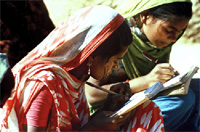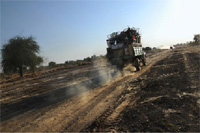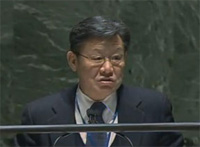
Education is a fundamental factor in achieving success and growth in different aspects of life. Education equips people with the knowledge to achieve all of the Millennium Development Goals by providing the skills to increase income, create employment opportunities, reduce hunger and poverty and enhance socio-economic development.
In the case of women, educating women and girls has proven to lead to higher earnings, improved child and family health and reduced fertility rates.
In 2000, world leaders adopted the United Nations Millennium Declaration where the second Millennium Development Goal (MDG-2) is to “Achieve Universal Primary Education,” ensuring that children across the globe will be able to complete a full course of primary schooling by 2015.
In an effort to improve education, the Economic and Social Council (ECOSOC) will follow the six goals of “Education for All” of the United Nations Educational, Scientific and Cultural Organization (UNESCO). These goals are: (1) expand early childhood care and education, (2) provide free and compulsory primary education for all, (3) promote learning and life skills for young people and adults, (4) increase adult literacy by 50 per cent, (5) achieve gender parity by 2005, gender equality by 2015 and (6) improve the quality of education.
The United Nations Children’s Fund (UNICEF) has prioritized the issue of equal access to education, empowerment of women through girls’ education and gender equality, education in emergencies and post-crisis education, early childhood development and school readiness and enhancing quality in primary and secondary education. To reach these goals, UNICEF has been working on a series of initiatives, including back on track education, back to school campaigns, child-friendly schools, school readiness, essential learning, learning plus and life skills based education.
Importance of Education
Education provides people with the ability to access tools that improves people’s lives. According to the Millennium Development Goals Report 2010, poverty and unequal access to schooling does not stop the high adolescent birth rates. In fact, unequal access to education jeopardizes the health and opportunities for social and economic advancement for girls and women.
The report also notes the social progress made from education. In particular, contraceptive use is four times higher among women with a secondary education than among those with no education. For women in the poorest households and among those with no education, negligible progress was seen over the last decade.
Children who receive early childhood care and education are more likely to develop basic cognitive and language skills, and be better socially and emotionally equipped. A proper education broadens opportunities for young people and helps develop the skills necessary to stimulate sustainable economic development.
Problems with Education
Some of the education implementation problems across the globe are due to the limited access to education, high drop out rates, grade repetition and poor quality of education. Today, at least 72 million children of school age are still denied the right to education due to financial, social or other challenges, including high fertility rates, HIV/AIDS and armed conflict.
In a report by UNESCO, titled “Education for All—Global Monitoring Report 2010: Reaching the Marginalized”, the publication estimated that achieving MDG-2 of universal primary education and goals of “education for all” across 46 low-income countries by 2015 would require an additional $24 billion per year in addition to the estimated existing national spending on basic education of $12 billion in 2007.
There is a fear that progress made in past 10 years will stall or be reversed as a consequence of the slower economic growth. In fact, many of the world’s poorest countries are not on track to meet the 2015 education targets.
In countries in which accessibility is not a problem, quality of the education available still remains a challenge. Of the students enrolled in school, millions drop out or leave school without having gained the most basic literacy and numeracy skills due to poor quality of education. To ensure schooling is useful, it is necessary to enforce proper infrastructure and a relevant curriculum.
Teachers are necessary to facilitate learning and education; therefore it is vital to make sure there is not a shortage of teachers. Furthermore, a shortage of teachers can be a major barrier to delivering education. To further ensure quality, teachers need to be well trained and motivated.
Secretary General Ban Ki-Moon elaborates on the importance to financing “Education for All” stating, that “aid for education produces great returns for poverty reduction, economic growth, child survival and democracy.”
For example, the abolition of primary school fees in Burundi resulted in a threefold increase in primary-school enrolment since 1999, reaching 99 percent in 2008.
Looking to the future
This year’s theme of the High-level Segment (HLS) of the ECOSOC Substantive Session in Geneva is education. The 2011 Annual Ministerial Review (AMR) will focus on the theme of “Implementing the internationally agreed goals and commitments in regard to education”. The theme aims to bring governments and civil society together to assess progress and challenges to ensure the MDG-2 is met by 2015.
To prepare for the 2011 AMR, ECOSOC is hosting events on the national, regional and global level. The activities include a philanthropy meeting on “partnering with the philanthropic community to promote education for all”, global preparatory meetings, regional preparatory meetings for Asia and the Pacific as well as the Arab region, national workshops and two e-discussions.
The e-discussions focus on “Building a future for today’s youth: improving access to education” and on “Education: Closing the Gap.” The e-discussion on closing the gap will provide an open multi-stakeholder forum for academia, policy-makers and practitioners to discuss the achievement of education and learning for all. The forum also offers stakeholders a venue to formulate concrete, actionable recommendations for consideration by the ECOSOC AMR.
The e-discussion on improving access to education is organized by DESA and the United Nations Academic Impact (UNAI) on Facebook. It intends to provide a platform for the youth to express themselves, mobilize governments and the international community, demonstrate a link between education and the MDGs, and highlight the role of UNAI and its member institutions.
ECOSOC hopes to finalize the session with a Ministerial Declaration on “Implementing the internationally agreed goals and commitments in regard to education”.
For more information: http://www.un.org/en/ecosoc/amr/index.shtml


